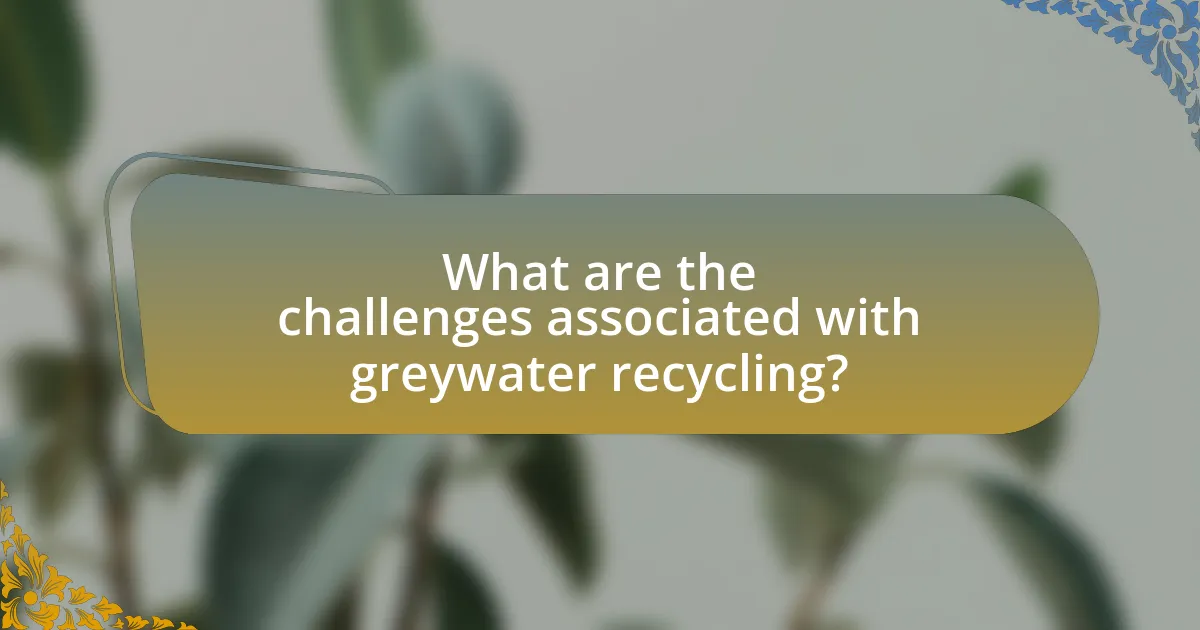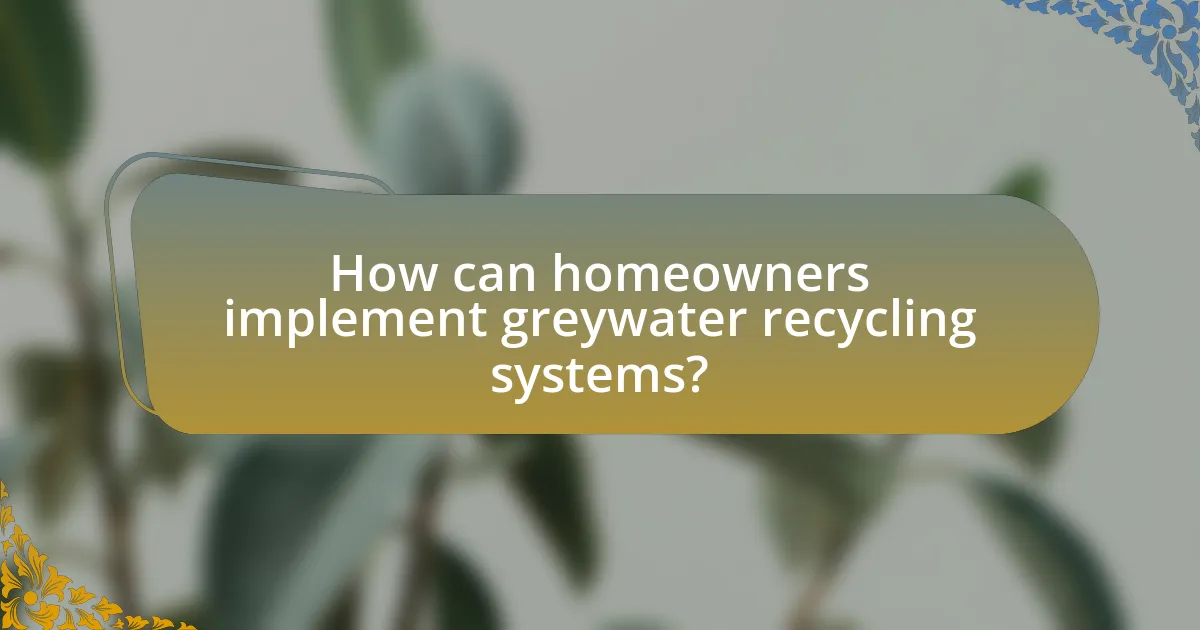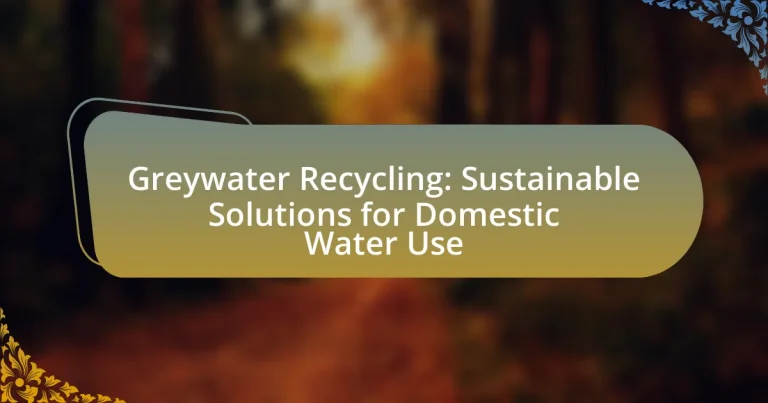Greywater recycling refers to the process of collecting and treating wastewater from domestic activities, such as bathing, laundry, and dishwashing, for reuse in non-potable applications like irrigation and toilet flushing. This practice is crucial for conserving freshwater resources, as greywater can account for up to 50% of residential wastewater. The article explores the definition and classification of greywater, its environmental and economic benefits, common recycling methods, and the challenges associated with its implementation. Additionally, it addresses health and safety concerns, regulatory frameworks, and best practices for homeowners to effectively adopt greywater recycling systems.

What is Greywater Recycling?
Greywater recycling is the process of collecting and treating wastewater generated from domestic activities, such as bathing, laundry, and dishwashing, for reuse in non-potable applications like irrigation and toilet flushing. This practice helps conserve freshwater resources and reduces the volume of wastewater entering sewage systems. According to the U.S. Environmental Protection Agency, greywater can account for up to 50% of residential wastewater, making its recycling a significant opportunity for water conservation.
How is greywater defined in the context of recycling?
Greywater is defined in the context of recycling as the relatively clean wastewater generated from domestic activities such as bathing, laundry, and dishwashing, excluding toilet waste. This definition is supported by the fact that greywater can be treated and reused for non-potable purposes, such as irrigation and toilet flushing, thereby conserving freshwater resources and reducing wastewater discharge. Studies indicate that recycling greywater can significantly decrease the demand for potable water, making it a sustainable solution for domestic water use.
What types of water are classified as greywater?
Greywater is classified as wastewater generated from domestic activities excluding toilet waste. This includes water from sinks, showers, bathtubs, washing machines, and dishwashers. Greywater typically contains fewer pathogens and nutrients compared to blackwater, which is sewage. The classification of greywater is supported by studies indicating that it can be reused for irrigation and non-potable applications, thus promoting sustainable water management practices.
What distinguishes greywater from other types of wastewater?
Greywater is distinguished from other types of wastewater by its source and composition, primarily originating from domestic activities such as bathing, laundry, and dishwashing, while excluding sewage from toilets. Unlike blackwater, which contains human waste and pathogens, greywater typically has lower levels of contaminants, making it more suitable for recycling and reuse in irrigation and non-potable applications. Studies indicate that greywater can contain beneficial nutrients, such as nitrogen and phosphorus, which can enhance soil fertility when used appropriately.
Why is greywater recycling important for sustainable water use?
Greywater recycling is important for sustainable water use because it significantly reduces the demand for freshwater resources. By treating and reusing water from sources like sinks, showers, and washing machines, households can conserve up to 50% of their water consumption. This practice not only alleviates pressure on municipal water supplies but also minimizes wastewater generation, contributing to environmental protection. Studies indicate that implementing greywater systems can lead to a reduction in water treatment costs and energy use associated with water distribution, further enhancing sustainability efforts.
What are the environmental benefits of greywater recycling?
Greywater recycling offers significant environmental benefits, primarily by reducing freshwater consumption and minimizing wastewater generation. By reusing water from sinks, showers, and washing machines, households can decrease their reliance on potable water sources, which helps conserve valuable freshwater resources. According to the U.S. Environmental Protection Agency, greywater recycling can reduce water usage by up to 50%, leading to less strain on local water supplies and ecosystems. Additionally, this practice lowers the volume of wastewater entering treatment facilities, which can reduce energy consumption and greenhouse gas emissions associated with wastewater treatment processes.
How does greywater recycling contribute to water conservation?
Greywater recycling significantly contributes to water conservation by reusing water from domestic activities such as bathing, laundry, and dishwashing for non-potable purposes like irrigation and toilet flushing. This process reduces the demand for freshwater sources, which is critical as global water scarcity affects over 2 billion people. By recycling greywater, households can decrease their overall water consumption by up to 50%, as evidenced by studies showing that implementing greywater systems can save approximately 30-50 gallons of water per day per household. This reduction in freshwater use not only conserves water resources but also lessens the burden on wastewater treatment facilities, promoting a more sustainable water management approach.
What are the common methods of greywater recycling?
Common methods of greywater recycling include filtration, biological treatment, and constructed wetlands. Filtration systems remove solids and contaminants from greywater, making it suitable for irrigation and toilet flushing. Biological treatment involves using microorganisms to break down organic matter in greywater, enhancing its quality for reuse. Constructed wetlands mimic natural processes to treat greywater through plant uptake and microbial activity, effectively purifying the water for non-potable applications. These methods are widely adopted due to their effectiveness in reducing water waste and promoting sustainable water management practices.
How do passive and active greywater systems differ?
Passive greywater systems rely on natural processes and gravity to filter and disperse greywater, while active greywater systems utilize mechanical components, such as pumps and filters, to treat and distribute the water. Passive systems often involve simple designs like mulch basins or constructed wetlands, which require minimal maintenance and energy input. In contrast, active systems can provide more efficient treatment and control over water distribution but typically involve higher operational costs and energy use. The distinction is significant as it affects installation complexity, maintenance requirements, and overall efficiency in greywater recycling.
What technologies are used in greywater treatment processes?
Greywater treatment processes utilize several technologies, including biological treatment, membrane filtration, and chemical disinfection. Biological treatment methods, such as activated sludge and biofiltration, rely on microorganisms to break down organic matter in greywater. Membrane filtration technologies, like microfiltration and ultrafiltration, effectively remove suspended solids and pathogens from the water. Chemical disinfection methods, including chlorination and ozonation, are employed to eliminate harmful microorganisms, ensuring the treated greywater is safe for reuse. These technologies collectively enhance the efficiency and safety of greywater recycling systems, contributing to sustainable domestic water use.

What are the challenges associated with greywater recycling?
The challenges associated with greywater recycling include contamination risks, regulatory hurdles, and technical complexities. Contamination risks arise from pathogens and chemicals present in greywater, which can pose health hazards if not properly treated. Regulatory hurdles often involve strict guidelines that vary by region, making compliance difficult for homeowners and businesses. Technical complexities include the need for specialized treatment systems that can effectively filter and purify greywater, which may require significant investment and maintenance. These challenges can hinder the widespread adoption of greywater recycling systems, despite their potential benefits for sustainable water use.
What health and safety concerns are related to greywater use?
Health and safety concerns related to greywater use primarily include the risk of pathogen exposure, chemical contamination, and environmental impact. Greywater, which is wastewater from sinks, showers, and washing machines, can contain harmful microorganisms such as bacteria, viruses, and parasites that pose health risks if ingested or if they come into contact with skin. Studies indicate that untreated greywater can harbor pathogens that may lead to gastrointestinal illnesses and skin infections. Additionally, greywater may contain residual chemicals from soaps, detergents, and personal care products, which can be toxic to humans and aquatic life. The Environmental Protection Agency (EPA) highlights that improper management of greywater can lead to soil and water contamination, further exacerbating health risks. Therefore, proper treatment and management practices are essential to mitigate these health and safety concerns.
How can pathogens in greywater be managed effectively?
Pathogens in greywater can be managed effectively through treatment processes such as filtration, disinfection, and biological treatment. Filtration removes larger particles and some pathogens, while disinfection methods, including chlorination, UV irradiation, or ozonation, effectively kill or inactivate remaining pathogens. Biological treatment, such as constructed wetlands or biofilters, utilizes microorganisms to break down organic matter and pathogens. Studies indicate that these methods can reduce pathogen levels significantly; for instance, UV treatment can achieve over 99.9% reduction in specific pathogens, making greywater safer for reuse in irrigation and non-potable applications.
What regulations govern the use of greywater in domestic settings?
Regulations governing the use of greywater in domestic settings vary by region but generally include guidelines on collection, treatment, and reuse. In the United States, for example, the Environmental Protection Agency (EPA) provides recommendations, while individual states have specific regulations; California’s Title 22 is a prominent example that outlines standards for greywater systems, including permitted uses and necessary treatment processes. These regulations aim to ensure public health and environmental safety by establishing criteria for the safe reuse of greywater, such as prohibiting its use for drinking water and requiring proper filtration and disinfection methods.
What are the economic implications of greywater recycling?
Greywater recycling has significant economic implications, primarily by reducing water costs and enhancing resource efficiency. By reusing greywater for non-potable applications such as irrigation and toilet flushing, households and businesses can lower their water bills, which can lead to savings of up to 50% on water expenses, as reported by the U.S. Environmental Protection Agency. Additionally, greywater recycling systems can increase property values, as homes equipped with such systems are often seen as more sustainable and environmentally friendly. Furthermore, the implementation of greywater recycling can alleviate pressure on municipal water supply systems, potentially reducing infrastructure costs for local governments. This economic benefit is particularly relevant in regions facing water scarcity, where the cost of sourcing new water supplies can be prohibitively high.
How does the initial investment compare to long-term savings?
The initial investment in greywater recycling systems typically ranges from $1,000 to $5,000, while long-term savings on water bills can exceed $1,000 annually, depending on usage. This means that over time, the savings from reduced water consumption can significantly outweigh the upfront costs. For example, a study by the American Water Works Association found that households implementing greywater systems can save up to 50% on their water bills, leading to a return on investment within 2 to 5 years. Thus, the financial benefits of long-term savings from greywater recycling often surpass the initial investment.
What incentives exist for homeowners to adopt greywater systems?
Homeowners can benefit from various incentives to adopt greywater systems, including financial rebates, tax credits, and reduced water bills. Many local governments and utilities offer financial rebates to offset the initial installation costs, which can range from $500 to $2,000 depending on the system and location. Additionally, some regions provide tax credits that can further reduce the financial burden of installation. By reusing greywater for irrigation and other non-potable uses, homeowners can significantly lower their water consumption, leading to reduced water bills. For example, studies indicate that greywater systems can reduce household water usage by up to 50%, translating into substantial savings over time.

How can homeowners implement greywater recycling systems?
Homeowners can implement greywater recycling systems by installing a greywater collection and treatment system that captures water from sinks, showers, and washing machines for reuse in irrigation or toilet flushing. This process typically involves setting up a filtration system to remove contaminants and a storage tank to hold the treated greywater. According to the U.S. Environmental Protection Agency, greywater recycling can reduce water usage by up to 50%, making it an effective method for conserving water resources. Additionally, local regulations often provide guidelines for safe installation and use, ensuring compliance with health and safety standards.
What steps should be taken to install a greywater system?
To install a greywater system, follow these steps: first, assess local regulations and obtain necessary permits, as compliance is crucial for legal installation. Next, identify the sources of greywater, such as sinks, showers, and washing machines, ensuring they are suitable for reuse. Then, select an appropriate greywater treatment system, which may include filtration and disinfection components to ensure water quality. After that, design the plumbing layout to direct greywater from the source to the treatment system and then to the intended reuse area, such as irrigation. Finally, install the system according to the manufacturer’s instructions and local codes, and conduct a test run to ensure proper functionality. These steps are essential for effective and compliant greywater system installation.
What are the key considerations for selecting a greywater system?
Key considerations for selecting a greywater system include local regulations, system type, water source, treatment level, installation requirements, maintenance needs, and cost. Local regulations dictate what types of greywater systems are permissible, influencing design and installation. The system type, such as simple diversion systems or more complex treatment systems, affects functionality and efficiency. The water source, typically from sinks, showers, or laundry, determines the treatment requirements. Treatment level is crucial for ensuring water quality meets safety standards for reuse. Installation requirements vary based on system complexity and local codes, while maintenance needs impact long-term usability and costs. Finally, cost considerations encompass both initial investment and ongoing operational expenses, making it essential to evaluate budget constraints against system benefits.
How can homeowners ensure compliance with local regulations?
Homeowners can ensure compliance with local regulations by researching and understanding the specific laws and guidelines related to greywater recycling in their area. This involves consulting local government websites, contacting municipal offices, and reviewing state regulations that govern water use and recycling practices. For instance, many jurisdictions require permits for greywater systems and adherence to specific installation standards to protect public health and the environment. By following these steps, homeowners can effectively navigate the regulatory landscape and implement greywater recycling systems that meet legal requirements.
What maintenance is required for greywater systems?
Greywater systems require regular maintenance to ensure optimal performance and prevent issues. Maintenance tasks include inspecting and cleaning filters, checking for clogs in pipes, and monitoring the system for leaks or odors. Additionally, it is essential to periodically assess the quality of the greywater being recycled to ensure it meets safety standards. Regular maintenance helps to extend the lifespan of the system and maintain its efficiency, as evidenced by studies indicating that well-maintained systems can reduce water usage by up to 50%.
How often should greywater systems be inspected and serviced?
Greywater systems should be inspected and serviced at least once a year. Regular inspections help identify potential issues such as clogs, leaks, or system malfunctions, ensuring the system operates efficiently and safely. According to the U.S. Environmental Protection Agency, annual maintenance is crucial for the longevity and effectiveness of greywater systems, as it allows for timely repairs and compliance with local regulations.
What common issues might arise with greywater systems?
Common issues that might arise with greywater systems include contamination, clogs, and odor problems. Contamination can occur if harmful substances, such as chemicals or pathogens, enter the greywater system, posing health risks. Clogs often develop in the filtration or distribution components due to the accumulation of soap scum, hair, and other debris, leading to system inefficiency. Odor problems can arise from stagnant water or the breakdown of organic matter, creating unpleasant smells. These issues highlight the importance of proper maintenance and monitoring to ensure the effective operation of greywater systems.
What best practices should homeowners follow for effective greywater recycling?
Homeowners should implement several best practices for effective greywater recycling, including using biodegradable soaps, properly maintaining the greywater system, and ensuring appropriate filtration. Biodegradable soaps minimize harmful chemicals in recycled water, making it safer for irrigation and other uses. Regular maintenance of the greywater system, such as checking for clogs and leaks, ensures optimal performance and longevity. Additionally, using a filtration system can remove larger particles and contaminants, enhancing the quality of the recycled greywater for safe reuse in landscaping and non-potable applications. These practices contribute to sustainable water management and reduce overall water consumption.
How can greywater be safely reused in landscaping?
Greywater can be safely reused in landscaping by implementing a proper filtration and distribution system that minimizes health risks. This involves using greywater from sources like sinks, showers, and washing machines, while avoiding water from toilets or kitchen sinks due to higher contamination levels. Systems such as subsurface irrigation or greywater treatment units can effectively filter and distribute the water, ensuring it meets safety standards for plant irrigation. Research indicates that treated greywater can reduce water consumption by up to 50% in landscaping, promoting sustainable water use while maintaining plant health.
What tips can enhance the efficiency of greywater systems?
To enhance the efficiency of greywater systems, implement proper filtration methods to remove contaminants effectively. Effective filtration, such as using sand or activated carbon filters, ensures that the greywater is clean enough for reuse, reducing the risk of clogging and system failure. Additionally, regular maintenance, including routine inspections and cleaning of components, can prevent buildup and prolong system lifespan. Research indicates that systems with consistent maintenance can operate up to 30% more efficiently than neglected systems. Furthermore, optimizing the design to include gravity-fed systems can reduce energy consumption, as gravity can facilitate water flow without the need for pumps.


